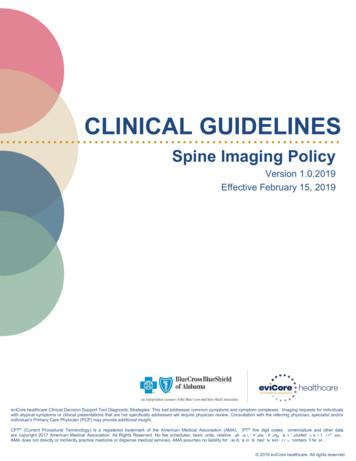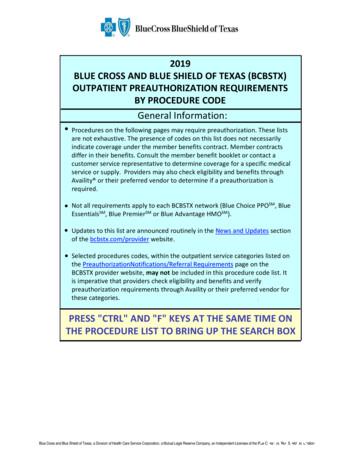EviCore Spine Imaging Guidelines - V1
CLINICAL GUIDELINESSpine Imaging PolicyVersion 1.0Effective January 1, 2021eviCore healthcare Clinical Decision Support Tool Diagnostic Strategies: This tool addresses common symptoms and symptom complexes. Imaging requests for individualswith atypical symptoms or clinical presentations that are not specifically addressed will require physician review. Consultation with the referring physician, specialist and/orindividual’s Primary Care Physician (PCP) may provide additional insight.CPT (Current Procedural Terminology) is a registered trademark of the American Medical Association (AMA). CPT five digit codes, nomenclature and other data arecopyright 2020 American Medical Association. All Rights Reserved. No fee schedules, basic units, relative values or related listings are included in the CPT book. AMA doesnot directly or indirectly practice medicine or dispense medical services. AMA assumes no liability for the data contained herein or not contained herein. 2020 eviCore healthcare. All rights reserved.
Spine Imaging GuidelinesV1.0Spine Imaging GuidelinesProcedure Codes Associated with Spine Imaging3SP-1: General Guidelines5SP-2: Imaging Techniques14SP-3: Neck (Cervical Spine) Pain Without/With NeurologicalFeatures (Including Stenosis) and Trauma22SP-4: Upper Back (Thoracic Spine) Pain Without/With NeurologicalFeatures (Including Stenosis) and Trauma26SP-5: Low Back (Lumbar Spine) Pain/Coccydynia withoutNeurological Features29SP-6: Lower Extremity Pain with Neurological Features(Radiculopathy, Radiculitis, or Plexopathy and Neuropathy) With orWithout Low Back (Lumbar Spine) Pain33SP-7: Myelopathy37SP-8: Lumbar Spine Spondylolysis/Spondylolisthesis40SP-9: Lumbar Spinal Stenosis43SP-10: Sacro-Iliac (SI) Joint Pain, InflammatorySpondylitis/Sacroiliitis and Fibromyalgia45SP-11: Pathological Spinal Compression Fractures48SP-12: Spinal Pain in Cancer Patients50SP-13: Spinal Canal/Cord Disorders (e.g. Syringomyelia)51SP-14: Spinal Deformities (e.g. Scoliosis/Kyphosis)53SP-15: Post-Operative Spinal Disorders56SP-16: Other Imaging Studies and Procedures Related to the SpineImaging Guidelines59SP-17: Nuclear Medicine63 2020 eviCore healthcare. All Rights Reserved.Page 2 of 64400 Buckwalter Place Boulevard, Bluffton, SC 29910 (800) 918-8924www.eviCore.com
Spine Imaging GuidelinesV1.0Procedure Codes Associated with SpineImagingCervical MRI without contrastCervical MRI with contrastCervical MRI without and with contrastThoracic MRI without contrastThoracic MRI with contrastThoracic MRI without and with contrastLumbar MRI without contrastLumbar MRI with contrastLumbar MRI without and with contrastSpinal Canal MRAMRI Pelvis without contrastMRI Pelvis with contrastMRI Pelvis without and with contrastMR SpectroscopyMagnetic resonance spectroscopy, determination and localization ofdiscogenic pain (cervical, thoracic, or lumbar); acquisition of single voxel data,per disc, on biomarkers (ie, lactic acid, carbohydrate, alanine, laal, propionicacid, proteoglycan, and collagen) in at least 3 discsMagnetic resonance spectroscopy, determination and localization ofdiscogenic pain (cervical, thoracic, or lumbar); transmission of biomarker datafor software analysisMagnetic resonance spectroscopy, determination and localization ofdiscogenic pain (cervical, thoracic, or lumbar); postprocessing for algorithmicanalysis of biomarker data for determination of relative chemical differencesbetween discsMagnetic resonance spectroscopy, determination and localization ofdiscogenic pain (cervical, thoracic, or lumbar); interpretation and reportCTCervical CT without contrastCervical CT with contrast (Post-Myelography CT)Cervical CT without and with contrastThoracic CT without contrastThoracic CT with contrast (Post-Myelography CT)Thoracic CT without and with contrastLumbar CT without contrast (Post-Discography CT)Lumbar CT with contrast (Post-Myelography CT)Lumbar CT without and with contrastCT Pelvis without contrastCT Pelvis with contrastCT Pelvis without and with contrastCPT 721957219672197763900609T0610T0611T0612TCPT 7219372194 2020 eviCore healthcare. All Rights Reserved.Page 3 of 64400 Buckwalter Place Boulevard, Bluffton, SC 29910 (800) 918-8924www.eviCore.comSpine ImagingMRI/MRA
Spine Imaging GuidelinesSpinal canal ultrasoundV1.0UltrasoundNuclear Medicine76800CPT 788037883078831Spine ImagingBone Marrow Imaging, LimitedBone Marrow Imaging, MultipleBone Marrow Imaging, Whole BodyBone or Joint Imaging, LimitedBone or Joint Imaging, MultipleBone Scan, Whole BodyBone Scan, 3 Phase StudyRadiopharmaceutical localization of tumor, inflammatory process or distributionof radiopharmaceutical agent(s) (includes vascular flow and blood poolimaging, when performed); planar, single area (e.g., head, neck, chest, pelvis),single day imagingRadiopharmaceutical localization of tumor, inflammatory process or distributionof radiopharmaceutical agent(s) (includes vascular flow and blood poolimaging, when performed); planar, 2 or more areas (e.g., abdomen and pelvis,head and chest), 1 or more days imaging or single area imaging over 2 ormore daysRadiopharmaceutical localization of tumor, inflammatory process or distributionof radiopharmaceutical agent(s) (includes vascular flow and blood poolimaging, when performed); planar, whole body, single day imagingRadiopharmaceutical localization of tumor, inflammatory process or distributionof radiopharmaceutical agent(s) (includes vascular flow and blood poolimaging, when performed); tomographic (SPECT), single area (e.g., head,neck, chest, pelvis), single day imagingRadiopharmaceutical localization of tumor, inflammatory process or distributionof radiopharmaceutical agent(s) (includes vascular flow and blood poolimaging, when performed); tomographic (SPECT) with concurrently acquiredcomputed tomography (CT) transmission scan for anatomical review,localization and determination/detection of pathology, single area (e.g., head,neck, chest, pelvis), single day imagingRadiopharmaceutical localization of tumor, inflammatory process or distributionof radiopharmaceutical agent(s) (includes vascular flow and blood poolimaging, when performed); tomographic (SPECT), minimum 2 areas (e.g.,pelvis and knees, abdomen and pelvis), single day imaging, or single areaimaging over 2 or more daysCPT 2020 eviCore healthcare. All Rights Reserved.Page 4 of 64400 Buckwalter Place Boulevard, Bluffton, SC 29910 (800) 918-8924www.eviCore.com
Spine Imaging GuidelinesV1.0SP-1: General GuidelinesSP-1.1: General ConsiderationsSP-1.2: Red Flag IndicationsSP-1.3: Definitions6912 2020 eviCore healthcare. All Rights Reserved.Page 5 of 64400 Buckwalter Place Boulevard, Bluffton, SC 29910 (800) 918-8924www.eviCore.com
Spine Imaging GuidelinesV1.0SP-1.1: General Considerations Before advanced diagnostic imaging can be considered, there must be an initialface-to-face clinical evaluation as well as a clinical re-evaluation after a trial of failedconservative therapy; the clinical re-evaluation may consist of a face-to-faceevaluation or other meaningful contact with the provider’s office such as email, webor telephone communications. A face-to-face clinical evaluation is required to have been performed within the last60 days before advanced imaging is considered. This may have been either theinitial clinical evaluation or a clinical re-evaluation. The initial clinical evaluation should include a relevant history and physicalexamination (including a detailed neurological examination), appropriate laboratorystudies, non-advanced imaging modalities, results of manual motor testing, thespecific dermatomal distribution of altered sensation, reflex examination, and nerveroot tension signs (e.g., straight leg raise test, slump test, femoral nerve tensiontest). The initial clinical evaluation must be face-to-face; other forms of meaningfulcontact (telephone call, electronic mail or messaging) are not acceptable as an initialevaluation. For those spinal conditions/disorders for which the Spine Imaging Guidelinesrequire a plain x-ray of the spine prior to consideration of an advanced imagingstudy, the plain x-ray must be performed after the current episode of symptomsstarted or changed (see: SP-2.1: Anatomic Guidelines). Clinical re-evaluation is required prior to consideration of advanced diagnosticimaging to document failure of significant clinical improvement following a recent(within 3 months) six week trial of provider-directed treatment. Clinical re-evaluationcan include documentation of a face-to-face encounter or documentation of othermeaningful contact with the requesting provider’s office by the patient (e.g.,telephone call, electronic mail or messaging). Provider-directed treatment may include education, activity modification, NSAIDs(non-steroidal anti-inflammatory drugs), narcotic and non-narcotic analgesicmedications, oral or injectable corticosteroids, a provider-directed homeexercise/stretching program, cross-training, avoidance of aggravating activities,physical/occupational therapy, spinal manipulation, interventional painprocedures and other pain management techniques. Altered sensation to pressure, pain, and temperature should be documented by thespecific anatomic distribution (e.g., dermatomal, stocking/glove or mixeddistribution). Motor deficits (weakness) should be defined by the specific myotomal distribution(e.g., weakness of toe flexion/extension, knee flexion/extension, ankle dorsi/plantarflexion, wrist dorsi/palmar flexion) and gradation of muscle testing should bedocumented as follows: 2020 eviCore healthcare. All Rights Reserved.Page 6 of 64400 Buckwalter Place Boulevard, Bluffton, SC 29910 (800) 918-8924www.eviCore.comSpine Imaging Any bowel/bladder abnormalities or emergent or urgent indications should bedocumented at the time of the initial clinical evaluation and clinical re-evaluation.
Spine Imaging Guidelines012345V1.0Grading of Manual Muscle TestingNo evidence of muscle functionMuscle contraction but no or very limited joint motionMovement possible with gravity eliminatedMovement possible against gravityMovement possible against gravity with some resistanceMovement possible against gravity with full or normal resistance Pathological reflexes (e.g. Hoffmann’s, Babinski, and Chaddock sign) should bereported as positive or negative. Asymmetric reflexes and reflex examination should be documented as follows:Grading of Reflex Testing01 2 3 4 No responseA slight but definitely present responseA brisk responseA very brisk response without clonusA tap elicits a repeating reflex (clonus) Advanced diagnostic imaging is often urgently indicated and may be necessary ifserious underlying spinal and/or non-spinal disease is suggested by the presence ofcertain patient factors referred to as “red flags.” See SP-1.2: Red Flag Indications. Spinal specialist evaluation can be helpful in determining the need for advanceddiagnostic imaging, especially for patients following spinal surgery. The need for repeat advanced diagnostic imaging should be carefully consideredand may not be indicated if prior advanced diagnostic imaging has been performed.Requests for simultaneous, similar studies such as spinal MRI and CT need to bedocu
(e.g., weakness of toe flexion/extension, knee flexion/extension, ankle dorsi/plantar flexion, wrist dorsi/palmar flexion) and gradation of muscle testing should be documented as follows: Imaging Guidelines V1.0 _ 2020 eviCore healthcare.
Code List references eviCore. For members attributed to Optum, preauthorization should be obtained from Optum, even if the applicable entry in the MAPD Benefit Preauthorization Procedure Code List references eviCore. Any entry that references eviCore should be preauthorized through eviCore except for members attributed to Optum.
Guidelines. eviCore Code Management for BCBS AL 3 Procedure Codes Associated with Spine Imaging 4 SP-1: General Guidelines 5 . ankle dorsi/plantar Guidelines V1.0. 2019 . Spine Imaging. flexion, wrist dorsi/palmar flexion) and gradation of muscle testing should be documented as follows: Grading of Manual Muscle Testing .
Procedure Code Service/Category 15824 Neurology 15826 Neurology 19316 Select Outpatient Procedures 19318 Select Outpatient Procedures 20930 Joint, Spine Surgery 20931 Joint, Spine Surgery 20936 Joint, Spine Surgery 20937 Joint, Spine Surgery 20938 Joint, Spine Surgery 20974 Joint, Spine Surgery 20975 Joint, Spine Surgery
Procedure Code Service/Category 15824 Neurology 15826 Neurology 19316 Select Outpatient Procedures 19318 Select Outpatient Procedures 20930 Joint, Spine Surgery 20931 Joint, Spine Surgery 20936 Joint, Spine Surgery 20937 Joint, Spine Surgery 20938 Joint, Spine Surgery 20974 Joint, Spine Surgery 20975 Joint, Spine Surgery
The result is a rapid, low-risk migration to or from an interoperable data center using best practices and protocols. Data Center Interconnect (DCI) DC-West Leaf Spine Leaf Spine Leaf Spine Leaf Spine Leaf Spine Leaf Spine DC-East Figure 5: Apstra manages all IP fabric egress points when connecting multiple data centers.
15 Dr. Frank Cammisa: 8 Top Challenges for Spine Surgeons This Year 16 Dr. Stephen Hochschuler: 8 Changes to Ensure a Brighter Future for Spine Surgery 18 7 Best Practices for Increasing Spine Center Profitability 31 10th Annual Orthopedic, Spine and Pain Management-Drive ASC Conference Sports Medicine 40 Dr. Brian Cole: 3 Exciting Trends in .
Musculoskeletal Imaging Guidelines Procedure Codes associated with Musculoskeletal Imaging 3 MS-1: General Guidelines 5 MS-2: Imaging Techniques 7 MS-3: 3D Rendering 12 MS-4: Avascular Necrosis (AVN)/Osteonecrosis 13 MS-5: Fractures 16 MS-6: Foreign Body 20 MS-7: Ganglion Cysts 22
Introduction to Academic Writing This study pack is designed to take about 50 minutes. It will give you an introduction to academic writing, sharing the most important principles that will guide you through writing during your degree at UCL. It was put together by the Writing Lab, which is the section of the Academic Communication Centre(ACC) that serves students from Bartlett; Psychology .






















